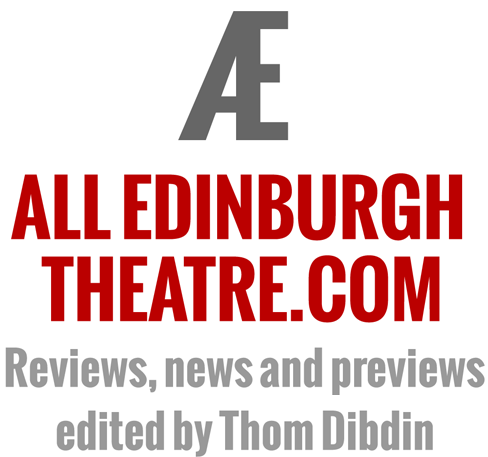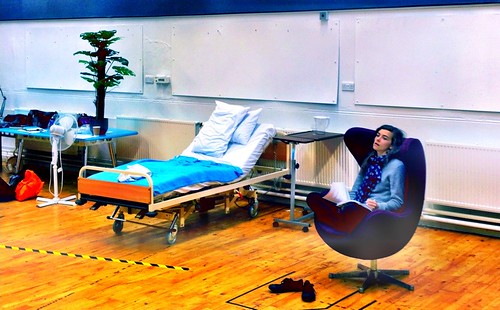The Dark Road Rushes – Five
Staggering through: Week four on the Royal Lyceum’s Dark Road
Almost there – The fifth rehearsal-room blog from Jo Rush, AD on Dark Road, the collaboration between crime writer Ian Rankin and Lyceum artistic director Mark Thomson.
The fourth week of rehearsals for Dark Road has seen us make the biggest transition of our rehearsal process so far – out of the rehearsal room and into the theatre. Hopefully the experience won’t prove as traumatic as the proverb that phrase is riffing on!
Having spent four weeks in the rehearsal room – which is over the road from the theatre itself – we had all become comfortable in that familiar environment and the theatre space had started to feel strangely distant, to me at least. But with the beginning of week four reality hit with a bump – the set was not only fully built but already being assembled in the theatre and the Lyceum’s excellent team of lighting, sound and technical crew were preparing for our arrival. Were we ready?
On Monday, while still in the rehearsal room, we attempted our first ‘stagger through’. This is a fairly self-descriptive name used for the first time you run the play all the way through from beginning to end. Whereas you might call this a full ‘run’ of the play describing it as a ‘stagger’ shows an awareness that everyone is doing this for the first time and are unlikely to be able to run before they can walk.
For the cast it is a particularly interesting experience to put all the scenes in order for the first time and see what stories are being told in the scenes that they don’t appear in and how different plot lines sit next to each other in the body of the play. On the technical side it was an opportunity for our lighting designer, Malcolm, to see the shape of the play, to see where the actors are moving and how they’re using the set so that he can plan how best to light the show and get as many of those lights set up in the theatre ahead of our arrival.
Stage management, wardrobe, and our designer Francis also watched the stagger through with a view to where changes could be made and how to plan for the smoothest possible working of the final show. It’s safe to say there was a high level of concentration in the room which, when combined with the tense nature of the play, left us completely wiped out afterwards.
Working on a brand new play usually means that adjustments are being made to the script until very late in the process. Previous new plays that I’ve worked on have even been subject to re-writes after their first previews! Keeping track of the many changes to the script along the way and making sure that a master copy of the script is kept up to date has been one of the tasks that myself and Dan, our wonderful deputy stage manager, have been grappling with on a daily basis. It’s so important to have a record of all the changes to the text because this will be the reference point for all the complicated cueing of lights, sound, and everything else so it needs to be as accurate as possible.
Bizarre moment of the week
Having returned to us from South Africa, Ian – ever the most culturally
savvy in the room – seemed to particularly enjoy explaining to two
younger members of the company what ‘twerking’ is!
After Monday’s stagger through Mark went away and made some cuts to the script to ensure that it would run at a good length on the stage and so on Tuesday we had to quickly take on these cuts and work with the actors whose lines were affected to get them used to the edits. Although it’s occasionally sad when the play loses a particular phrase you’ve grown attached to, most of the cuts have simply helped us to avoid saying the same thing twice or introducing information tangents that aren’t needed in a scene so the play now flows even better as a result.
After this the bulk of our fourth week was all about repetition, repetition, repetition. Going over scenes again and again to get them built into the cast’s muscle memory and giving extra time to scenes or sections that caused difficulties to the actors so that they could overcome any problems and hone the scene through consistent practice.
By lunchtime on Friday we were ready to run! We had a proper full run of the show that afternoon in the rehearsal room with the whole production team watching and the difference that those four days had made was remarkable. With that done there was only one thing left to do – pack up our props and set and move into the theatre.
And that’s where we’ve been for the last few days. Getting used to our new home, trying to understand the intricacies of the set, seeing costume, set, lighting and sound all finally come together. There’s a lot that is still to be figured out before opening night but it’s going to be amazing to see it get there through this final push.
Jo Rush is a director and theatre maker based in Edinburgh. Having just completed a successful run at the Edinburgh Fringe with the production Hide And Seek, a devised piece of immersive physical theatre, she is now working as assistant director to Mark Thomson at the Lyceum on Dark Road, a new play by Ian Rankin and Mark Thomson, a role that has been made possible through the support of the Federation of Scottish Theatre.
Previously Jo has worked as assistant director at the Traverse and directed work as part of new writing events such as Words, Words, Words and the experimental theatre project Scrapyard, both at the Traverse, as well as directing work at the Fringe in both 2011 and 2012. Jo is interested in visual storytelling, classic works, and developing new writing.
Dark Road opens at the Lyceum on Saturday 28 September, running through to 19 October with previews on 25 to 27 September.
Full details of Dark Road on the Royal Lyceum’s website: www.lyceum.org.uk.
ENDS
© Jo Rush 2013.



















